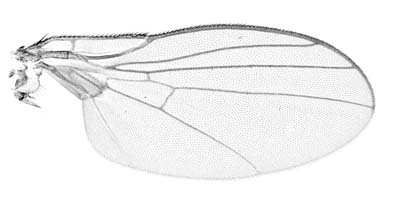|
||||||
|
Liriomyza
bryoniae (Kaltenbach, 1858) Tomato Leaf-miner Agromyza
bryoniae
Kaltenbach, 1858. Verh. naturh. Ver. preuss. Rheinl. 15:
158 |
||||||||||||||||||||||||||||||||||||||||||||||||||||||||||||||||||||||||||||||||||||||||||||||||||||||||||||||||||||||||||||||||||||||||||||||||||||||||||||||||||||||||||||||||
|
Leaf-miner: A short, irregular, linear upper surface mine on any part of the leaf. Also recorded from young pods (Bland, 1997a). Long corridor mine. As a rule the first part of the mine is lower-surface, the later part upper-surface. Often the loops are so dense that a secondary blotch is the result. Because upper- and lower-surface corridor segments often cross, the mine obtains a strange array of transparant patches. There is no association with the midrib. Frass in strings and thread fragments. Pupation outside the mine; exit slit in upper epidermis (Bladmineerders van Europa). Mine not associated with the veins or midrib of the leaf (It is this character which enables distinction from another Agromyzid pest species - Liriomyza huidobriensis). The larvae may leave one leaf (if not large enough) and enter another leaf, via the petiole). It exits the leaf to pupate through a semi-circular slit in the upper surface of the leaf (British leafminers). Larva: The larvae of flies are leg-less maggots without a head capsule (see examples). They never have thoracic or abdominal legs. They do not have chewing mouthparts, although they do have a characteristic cephalo-pharyngeal skeleton (see examples), usually visible internally through the body wall. The larva is described by Dempewolf (2001: 148) and illustrated in Bladmineerders van Europa. Puparium: The puparia of flies are formed within the hardened last larval skin or puparium and as a result sheaths enclosing head appendages, wings and legs are not visible externally (see examples). Pale yellowish-brown; posterior spiracles each with an ellipse of 7-12 bulbs. Adult:
The adult is illustrated in the Encyclopedia of Life. Comments: A highly polyphagous species principally mining Cucurbitaceae and Solanaceae, although recorded on hosts in numerous other plant families. A pest of tomatoes in glasshouses. A significant pest on several genera of cultivated cucurbits in Europe, but rarely found on its original host Bryonia (Spencer, 1990). Hosts cited here include 119 plant genera in 31 plant families of which only 4 plant genera in 2 plant families are records in Britain. A serious pest in the Mediterranean area of tomatoes and has been recorded as a pest of tomatoes in glasshouses in England, The Netherlands and Denmark. In France tomatoes, melon, cucumber and lettuce have been attacked (Spencer, 1973a). A major pest species on a large range of species, which forms irregular twisting mines, which are not associated with the veins or midrib of the leaf (It is this character which enables distinction from another Agromyzid pest species - Liriomyza huidobrensis). The larvae may leave one leaf (if not large enough) and enter another leaf, via the petiole). It exits the leaf to pupate through a semi-circular slit in the upper surface of the leaf. Highly polyphagous and mainly restricted to greenhouses and botanical gardens, where it is a particular pest of Tomatoes. Large infestations can cause reduced fruit yield and even death of the plant (British leafminers) In Northern Ireland Liriomyza bryoniae is listed in the European Community Plant Health Directive (2000/29/EC). As a non-native notifiable pest species, its occurence in the United Kingdom should be notified immediately to the Plant Health and Seeds Inspectorate (tel: +44 (0) 1904 462000, e-mail: info@fera.gsi.gov.uk ) However, in order to be certain of the identity, the male genitalia should be critically examined. Diagnostic protocols may be found at /protocols/liriomyza.pdf - See also Collins (1996). Bland (1997a) records mines of bryoniae in young seed pods of Pisum sativum - mangetout purchased in Scotland - which, from enquiries he made, suggested came from southern France. Minkenberg and Lenteren (1986) review the hosts and parasites of Liriomyza bryoniae. Arabis glabra is treated as Turritis glabra (Tower Mustard) and Lycopersicon esculentum is treated as Solanum lycopersicum (Tomato) by Stace (2010). Hosts in Great Britain and Ireland:
Hosts elsewhere: Alismataceae, Amaranthaceae, Apiaceae, Asteraceae, Basellaceae, Brassicaceae, Caryophyllaceae, Chenopodiaceae, Cucurbitaceae, Euphorbiaceae, Fabaceae, Gentianaceae, Hydrophyllaceae, Lamiaceae, Loasaceae, Malvaceae, Oxalidaceae, Pedaliaceae, Piperaceae, Plantaginaceae, Polemoniaceae, Primulaceae, Scrophulariaceae, Solanaceae, Valerianaceae and Verbenaceae. Time of year - mines: June -September (British leafminers) Time of year - adults: Currently unknown. Distribution in Great Britain and Ireland: Local, probably introduced. Surrey (Kew Gardens), Hertfordshire (Cheshunt), Sussex (Worthing) (Spencer, 1972b: 52), Channel Is. (Fauna Europaea). As far north as East Yorkshire in glasshouses where tomato, pepper and less often, cucumber are grown (Dom Collins, pers. comm.). Distribution elsewhere: Widespread in continental Europe particularly in Botanical Gardens and glasshouses. France, Denmark, Finland, Norway, Sweden (Spencer, 1976: 234), The Netherlands (Bladmineerders van Europa), Belgium (de Bruyn and von Tschirnhaus, 1991), Germany (Dempewolf (2001: 148), Albania, the Ukraine and the Caucasus (Spencer, 1976: 234), Lithuania (Ostrauskas, Pakalniskis and Taluntyte, 2003), Austria, Azores, Belarus, Bulgaria, Canary Is., Corsica, Crete, Croatia, Czech Republic, Estonia, European Turkey, Greek mainland, Hungary, Italian mainland, Malta, Republic of Moldova, Poland, Portuguese mainland, Sicily, Slovenia, Spanish mainland and Yugoslavia (Fauna Europaea). Also known in Egypt (Spencer, 1976: 234). NBN Atlas links to known host species: British and Irish Parasitoids in Britain and elsewhere:
|
| Last updated 09-Jul-2020 Brian Pitkin | ||

